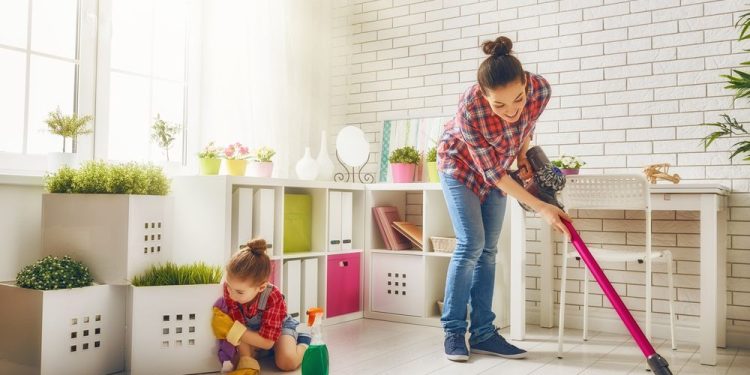In the pursuit of overall well-being, the significance of our living environments cannot be overstated. Creating a home that nurtures health and vitality involves considering various elements within our living spaces. Every aspect plays a crucial role in shaping our daily experiences, from the air we breathe to the materials surrounding us. This article explores eight essential ways to cultivate a healthier home environment, offering practical tips for individuals seeking to enhance their living spaces. Ventilation emerges as a critical factor, emphasizing the importance of fresh air circulation to combat indoor pollutants. Additionally, adopting natural cleaning products contributes to a chemical-free atmosphere, promoting physical and environmental wellness. Integrating indoor plants, choosing filtered water options, and prioritizing mindful lighting are further explored as methods to foster a harmonious living space. The article also underscores the importance of reducing clutter and opting for sustainable, non-toxic decor elements, ultimately emphasizing the holistic approach to creating a home that promotes health and vitality.
Table of Contents
Optimize Ventilation
Ventilation is the cornerstone of a healthier home environment, which ensures the continuous exchange of indoor and outdoor air. Adequate ventilation brings fresh air into living spaces and mitigates the accumulation of indoor pollutants. Opening windows and doors regularly facilitates optimal air circulation, removing stagnant air and promoting a more stimulating atmosphere. This practice proves particularly beneficial in areas where pollutants from cooking, cleaning products, and other household activities can accumulate. Embracing natural ventilation methods is cost-effective and aligns with sustainable living practices, reducing the reliance on energy-consuming air circulation systems. Moreover, the introduction of cross-ventilation by strategically placing windows on opposite sides of a room maximizes airflow effectiveness. By prioritizing ventilation, individuals can create a living space that is aesthetically pleasing and conducive to respiratory health and overall well-being. In essence, optimal ventilation is the foundational step towards cultivating an environment that fosters a breath of fresh, revitalizing air.
Use Natural Cleaners
Using natural cleaning products is fundamental to creating a healthier home environment. Embracing eco-friendly and natural cleaning products is a conscious choice that goes beyond mere aesthetics, contributing significantly to the well-being of individuals and the environment. Unlike conventional cleaning agents laden with harsh chemicals, natural alternatives harness the power of plant-based ingredients, essential oils, and other biodegradable components. This shift minimizes exposure to potentially harmful substances and reduces the environmental impact associated with the production and disposal of chemical-laden cleaners. Natural cleaning products, often cruelty-free and without synthetic fragrances, cater to individuals with sensitivities and allergies, fostering a safer and more inclusive living space. These eco-friendly alternatives align with sustainable living practices, promoting a harmonious coexistence with nature. Beyond their health benefits, natural cleaning products are committed to ethical consumer choices, supporting companies prioritizing eco-conscious manufacturing processes. Furthermore, individuals can easily create natural cleaning solutions using everyday household items such as baking soda, vinegar, and lemon. This DIY approach reduces reliance on commercial products and adds a personal touch to home care routines. Adopting natural cleaning products is a transformative step towards cultivating a home environment that champions health, sustainability, and a genuine connection with the surrounding ecosystem.
Grow Plants
Growing plants helps to improve indoor air quality and enhances everyone’s well-being. Indoor plants act as natural air purifiers, absorbing pollutants and releasing oxygen, creating a healthier and more balanced atmosphere. Beyond their air-purifying qualities, plants contribute to a sense of connection with nature, promoting mental well-being and reducing stress levels. Selecting various indoor plants with different shapes and sizes adds aesthetic appeal to living spaces, creating a visually pleasing and vibrant environment. Caring for indoor plants can also be a fulfilling and meditative experience, fostering a sense of responsibility and connection with the natural world. Consider incorporating low-maintenance plants such as snake plants, pothos, or succulents for those with busy schedules or minimal gardening experience. Choosing plants that thrive indoors is essential, considering factors like light availability and humidity levels. The strategic placement of plants in different rooms ensures a widespread distribution of their benefits throughout the home. Ultimately, integrating indoor plants into the living space is a holistic approach that enhances air quality and contributes to a more serene, nature-inspired ambiance.
Select Filtered Water Options
Choosing filtered water options within the home ensures access to clean and contaminant-free water. Installing a water filtration system is a proactive measure that addresses concerns related to water quality, removing impurities and potential contaminants that may be present in tap water. Filtration systems come in various forms, such as pitcher filters, faucet-mounted filters, or under-sink systems, providing flexibility based on individual preferences and household needs. Filtered water not only enhances the taste and odor of drinking water but also contributes to the overall health of individuals by reducing exposure to harmful substances. Common contaminants like chlorine, lead, and microbial elements are effectively filtered out, safeguarding against potential health risks associated with their consumption. In addition to promoting better health outcomes, opting for filtered water aligns with environmentally conscious practices by reducing the reliance on single-use plastic water bottles, thereby minimizing plastic waste. The convenience of having access to clean water at home encourages adequate hydration, a key element in maintaining overall well-being. By making the conscious choice to install water filtration systems, individuals contribute to creating a home environment that prioritizes health and environmental sustainability.
Use the Right Lighting
Making mindful lighting choices is crucial in creating a healthier home environment. Opting for natural light whenever possible is a cornerstone of this approach, harnessing the positive effects of sunlight on mood and well-being. Sunlight exposure helps to regulate circadian rhythms, promoting a healthier sleep-wake cycle and positively influencing mental health. In spaces where natural light may be limited, selecting energy-efficient bulbs with a color temperature that mimics natural daylight is essential. These bulbs not only provide adequate illumination but also contribute to creating a more soothing and adaptable lighting environment. Installing dimmer switches allows for customization, enabling individuals to adjust lighting levels according to specific activities or times of day. Mindful lighting choices extend beyond functionality, incorporating elements of aesthetics and ambiance. Consider incorporating task lighting for focused activities, ambient lighting for a relaxed atmosphere, and accent lighting to highlight specific features or areas within the home. This intentional approach to lighting design enhances the overall visual appeal of living spaces while fostering an environment that aligns with both physiological and psychological well-being. In essence, mindful lighting transforms a home into a dynamic and health-supportive space that adapts to its inhabitants’ changing needs and moods.
Reduce Clutter
Reducing the amount of clutter in your home helps to make it look prettier and increases the quality of the air inside your home. Clutter not only affects the visual harmony of a home but can also harbor dust and allergens, contributing to poor indoor air quality. Adopting a minimalist approach by decluttering living spaces creates an environment that is visually appealing and easier to clean and maintain. By systematically organizing belongings and eliminating unnecessary items, individuals reduce the surfaces on which dust and pollutants can accumulate. This promotes a healthier living space with improved air quality, benefiting respiratory health and overall well-being. Decluttering extends to all home areas, from the bedroom to common areas, fostering an environment that promotes relaxation and mental clarity.
Furthermore, a clutter-free home has been linked to reduced stress levels and improved mental focus. Simplifying one’s surroundings can lead to a sense of order and tranquility, positively impacting mental well-being. Embracing the principle of “less is more” in terms of possessions contributes to a home environment that prioritizes physical health and mental and emotional harmony. Reducing clutter is a transformative step towards creating a living space that fosters cleanliness and a sense of calm.
Select the Right Mattress
Using the best non toxic mattress is a critical element in creating a healthier sleep environment. Conventional mattresses may contain harmful chemicals such as flame retardants, formaldehyde, and volatile organic compounds (VOCs), which can off-gas and contribute to indoor air pollution. Opting for organic or natural mattresses crafted from organic cotton, natural latex, or wool provides a healthier alternative, minimizing exposure to these potentially harmful substances. Non-toxic mattresses are particularly beneficial for individuals with sensitivities or allergies, as they reduce the risk of skin irritation and respiratory issues associated with chemical exposure during sleep. Additionally, organic mattresses are often produced using environmentally sustainable practices, contributing to a more eco-friendly home. Choosing a toxic-free mattress extends beyond health considerations; it also significantly promotes restful sleep. The comfort and support provided by natural materials contribute to a more comfortable and rejuvenating sleep experience. Investing in a mattress that prioritizes health and sleep quality aligns with cultivating a home environment that supports overall well-being, from waking hours to restful nights.
Pick Out Sustainable Furniture and Decor
Use furniture and home decor items made from sustainable, non-toxic materials. They help create a home environment that is aesthetically pleasing and environmentally friendly. Sustainable furniture options typically use reclaimed wood, bamboo, or recycled metal, reducing the ecological impact associated with conventional manufacturing processes. Choosing non-toxic materials in furniture and decor helps minimize indoor air pollution, as many conventional products may release harmful chemicals over time. Opting for items that are free from formaldehyde, flame retardants, and other harmful substances enhances indoor air quality and supports a healthier living space. Beyond the health and environmental benefits, sustainable and non-toxic furniture often boasts unique and timeless designs. Investing in well-crafted, durable pieces reduces the need for frequent replacements, contributing to a more sustainable and mindful approach to consumption. Consider exploring second-hand or vintage furniture options, promoting a circular economy and adding character to the home. By prioritizing sustainability and non-toxicity in furniture and decor choices, individuals contribute to creating a home environment that reflects their style and a commitment to the well-being of both occupants and the planet.
Conclusion
Cultivating a healthier home environment involves a holistic approach encompassing various daily living aspects. The eight strategies outlined above provide a comprehensive guide for individuals seeking to transform their living spaces into havens of well-being. From optimizing ventilation and embracing natural cleaning products to integrating indoor plants and choosing filtered water options, each recommendation contributes to a home environment that nurtures physical health and environmental sustainability. Mindful lighting choices, reduced clutter, and the selection of non-toxic mattresses underscore the importance of creating spaces that support mental and emotional well-being. Choosing sustainable and non-toxic furniture and decor adds the finishing touch to an aesthetically pleasing and environmentally conscious home. By implementing these strategies, individuals enhance the quality of their daily lives and contribute to a broader movement towards sustainable and health-oriented living. As we recognize the interconnectedness of our well-being with the spaces we inhabit, the journey towards a healthier home becomes a meaningful step towards a more harmonious and balanced life. Ultimately, these intentional choices empower individuals to create environments that reflect their values, promoting health, sustainability, and a sense of sanctuary within the walls of their homes.


 Home
Home










